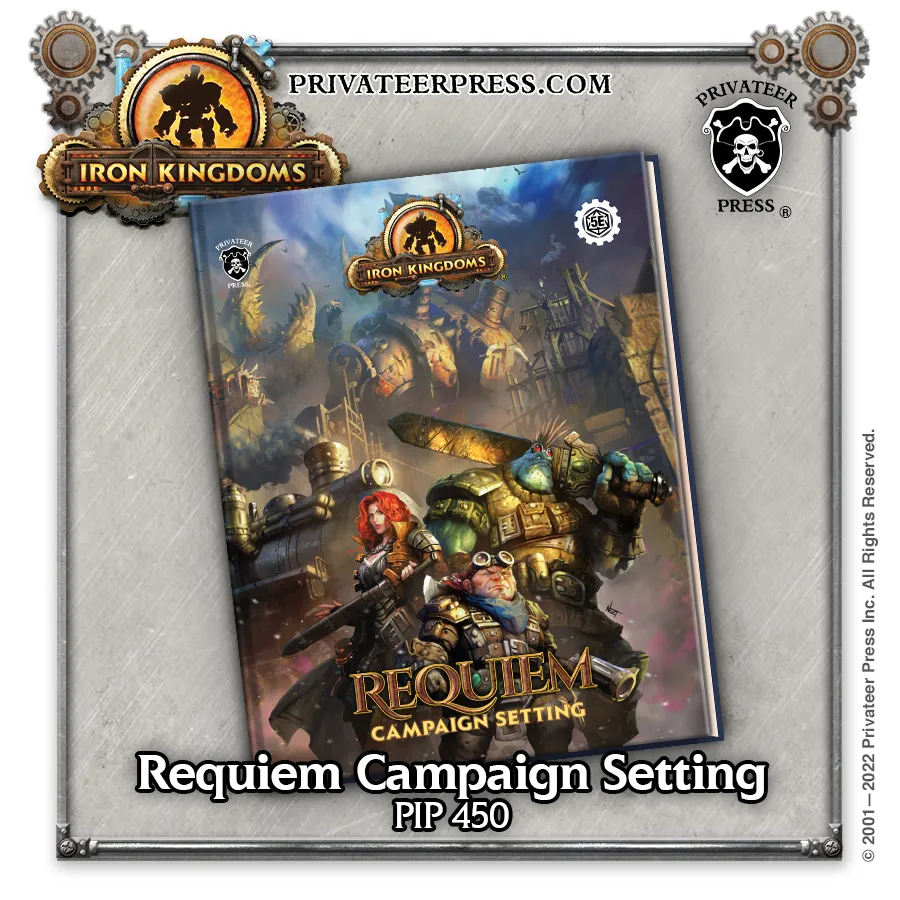Do you like tabletop role-playing games? What if there were massive mechanical war machines fueled by magic and coal? Iron Kingdoms: Requiem is a massive release including books and accessories on top of the deep inventory of official miniatures from Privateer Press. Let's take a peek!
Requiem Campaign Setting
This book is essentially a combined Player's Handbook and Dungeon Master's Guide introducing all the core aspects of the Iron Kingdoms. The core rulebooks are still necessary for general information though. Think of this as a supplement rather than a replacement.
Chapter 1
Our setting opens appropriately enough with the history and current events of the setting, including several adventure hooks tied to these locations.
Chapter 2
Character options lean on the Dungeons & Dragons structure, but begins with the option of choosing an Essence in place of the usual racial bonuses and attributes. Iron Kingdoms race options also diverge from the standard PHB choices as follows.
Gobbers: think of a blend between classic D&D halflings and goblins. Gobbers tend to coexist with other races as charismatic traders and tinkers. They typically have large pointy ears, greenish skin, and toothy maws.
Humans: divided by the titular Iron Kingdoms into various nationalities, humans have various traits defined by whether they are from Cygnar, Menoth, Khador, Llael, Ord, and Cryx. Other human cultures tended to have been slaughtered or subsumed by these dominant powers.
Iosans: slender, longer-lived humanoids with a dark history and dwindling numbers. Elves, basically, but grim.
Nyss: nomadic ice elves who can live even longer, up to 400 years. They were once driven to the inhospitable northern wastes, but are now refugees due to the return of the dragon Everblight.
Ogrun: basically a blend of ogre and D&D goliath characteristics with a clannish culture favoring military adventure and lawful alignments. Some are allied with the Rhulfolk.
Rhulic Dwarves: less beardy than the standard fantasy trope race, but even more fascinated with modern steam-and-magic technology! They also get firearms training by default.
Trollkin: big, rowdy, tough, gray-blue folk who value family, honor, and courage. If you like feasting and fighting, these are your people!
Classes and subclasses also get a restructuring to fit the Iron Kingdoms setting. The Player's Handbook options all still exist, plus there are some setting-specific divine domains for clerics, martial archetypes for fighters, monastic traditions for monks, sacred oaths for paladins, ranger archetypes, and roguish archetypes.
This book adds Alchemist, Gun mage, Gunfighter, Mechanik, and Warcaster. We also have the addition of simple and martial firearms, with the option to swap from standard weapon proficiency into the equivalent firearm proficiency instead, or add the optional "firearm training" feat. Warcasters can also bond with a steamjack, a big stompy war machine they can command in combat.
Finally, there are several Iron Kingdoms backgrounds to better fit a character to the world, and options for adventuring companies to add structure to a campaign. Do you want to be a pirate crew, or a secret cult? There's a framework for these and many more.
Chapter 3
Magic in the Iron Kingdoms relies on seeing and shaping mystical runes of arcane power. Material components are rarely used, and spellcasters instead use word and gesture as mnemonic devices to produce these glowing runes. Warcasters can also equip their steamjacks to channel magic and serve as the point of origin for their spells.
Spell lists for the arcane classes and subclasses in this book, but the new spells added to the standard Player's Handbook class options appear later on in chapter 6.
Chapter 4
Equipment in the Iron Kingdoms includes new firearms, bayonets, steam armor, and the off-hand master plan of wielding a coal shovel. This chapter has the stats for all the cool weapons and mechanikal wonders of the Iron Kingdoms along with useful adventuring gear However, the coolest stuff awaits in...
Chapter 5
STEAMJACKS! The war machines that game a name to the Warmachine game are right here. Learn all about how to maintain the steam-powered engine and magic-powered cortex while it unleashes melee and ranged attacks with its heavy weaponry. Upgrade and improve your steel-and-brass friend. Fear the catastrophic damage table. This is probably the most iconic section for the setting if you're approaching it from the tabletop game scene.
Chapter 6
The Game Master's Guide lists new spells for old classes, old spells that don't exist in this new setting, fatigue points as an alternative to spell slots, how to integrate PHB races and classes, plot structures for campaigns, and NPC statistics for allies and adversaries.
Closing Thoughts
If I have any complaints about this book, it's the lack of Hordes-related content, but this is just the first book for the setting, and at 268 pages, it's not as though it's short on content as it stands. The Iron Kingdoms themselves offer plenty of campaign ideas and varied adventures, and the worldbuilding offered in the first chapter alone should help guide major plot points in any adventure. I had intended to write about everything I have so far for this game, but just the core book took a lot of description. Keep an eye out for at least one more review, because I am only scratching the surface of my loot haul here!

How's this for a teaser?
The product image from Privateer Press is a hyperlink to their store page. I have no affiliate relationship with Privateer Press and gain nothing from your clicks. Buy from your friendly local game shop or other online retailers if you prefer.

